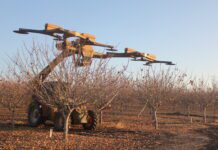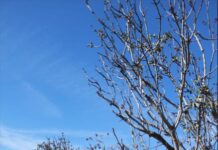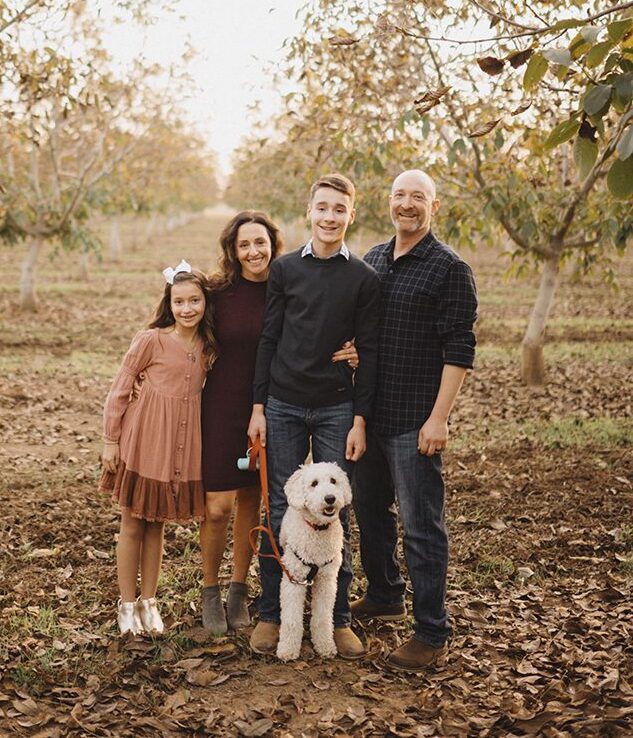
Family farms are evolving to stay afloat, and nowhere is that more evident than at Machado Family Farms where Drew and Melissa Machado Cheney are investing in sustainable agricultural practices and new revenue streams, including a gym on the farm that includes a focus on “farm fitness” to create a legacy to pass on to the next generation.
Even as they look to educate their community through school visits to the farm and farm-to-table events, Melissa and Drew never thought they would end up back on Melissa’s family farm. They both had successful jobs, Melissa in healthcare and Drew working as an ombudsman for the state, but when no one else wanted to take over the 80-year-old farming operation, Melissa and Drew stepped up.
“For me, at first, it was pretty much a hard no because I knew what that farming life was like, and we were happy in Sacramento,” Melissa says. “I was working for a large healthcare corporation, but at the same time, we both grew up in the country and wanted to eventually live and raise our children in a rural setting. His dad oversaw a rice-drying and storage operation, so we knew we wanted to be back in that lifestyle someday.”
After much discussion, they decided to move back to the farm, and since then they have been focused on integrating sustainable farming practices like cover cropping and using sheep in the orchards as well as sharing their love of fitness with the community. They built a gym on the farm where both Drew and Melissa teach classes as part of their commitment to helping others live a healthy lifestyle.
We asked them to share with West Coast Nut readers how they approach family farming and their views on the state of the tree nut industry.
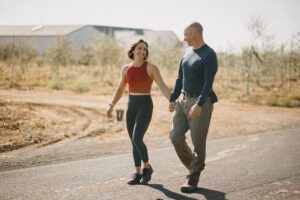
Q. What is the history of your farming operation?
Melissa: Our farm originated in the early 1900s. My great-grandfather actually immigrated over here from the Azores, and he started with sheep and dairy cows on our home ranch. Then, years later, he moved into row crops and eventually orchards once my dad and my uncle came back from college. We are actually the fourth generation taking over the farm.
We have our home ranch. We actually still have the original house. Now, we have a little over 1,000 acres that we’ve accumulated. We do rent some, but we farm over 1,000 acres.
Drew: I think a really important point to make is the accumulation of the farm was cyclical. Melissa’s grandfather’s dream was to get the original home ranch back together because different family members had sold off parcels. It was literally a dying dream of his to make sure that the home ranch was brought back together in one piece, and so that happened within the last 20 years, and he was finally able to get everything back together under their family.
Q. How did you enter the family business?
Melissa: Originally, my great-grandfather immigrated over here and started with that very small plot of land. Then my grandfather and one of his sons and a great-uncle of mine formed the ranch. As my dad and uncle got older, they helped on the ranch, both going to college and then coming back to work on the farm.
There are eight grandchildren within our Machado family. I’m one of three; I have two brothers. My late brother passed away on the farm 26 years ago, and my other brother is in Canada, while the rest of our cousins are dispersed literally across the world.
About 11 years ago, we were living in Sacramento, and it was kind of a transitional spot for our family and the farm. Everyone went to college, got married, started settling down and having families. My grandfather’s health took a nosedive, so he really wasn’t active on the farm anymore. It was just my dad and my uncle, but their capacity was becoming limited. We do have a team of five employees to help. My late brother was very instrumental in helping, and obviously, we no longer had his help.
So the big question was, “What’s going to happen to the farm? Who’s going to take it on?” That question was put out basically to the entire family, asking if anyone was interested in coming back to take it on or if we were going to lease out all the land we owned. We are one of three of the cousins who live in California. So my dad posed the question to us: Would we be willing to move back?
Drew: And I think part of it, too, is two of her cousins had come back to work on the farm, but sometimes things just aren’t a fit, and it wasn’t a fit for them. It’s not a reflection on their abilities or intentions; it just wasn’t right for them. But it really was a bit of quiet desperation on Melissa’s father’s part.
For me and Melissa, she was doing very well in the corporate world, and I really enjoyed my role with the state. So, to ask us to come back and basically leave everything we had worked for, it was one of those conversations where we sat down, opened a bottle of wine and weighed the pros and cons, discussing if we’d feel comfortable or not.
Melissa: In my gut and heart, I felt the legacy of our farm, decades of blood, sweat and tears that went into it. I had put in work on the farm as a young girl and experienced so much about that life. There were so many positive things about it, and the thought of leasing the land out was not OK. There was no way, after where we came from and the sacrifices made to grow the farm, purchase land and get to where we were. My dad was instrumental in changing how we farm, bringing in orchards, and moving away from row crops. I couldn’t let it go; that would have killed me.
I had always said I’d never marry a farmer, but thinking about the bigger picture, the legacy for our future generations, our children and the dying art of small family farms, I couldn’t just let the farm lease out to other growers. Family farmers need to stick together. That was what drove my decision, and I was ready to say OK as long as Drew supported it. But I was wary because working with family is always hard.
I knew it would be very challenging for Drew to work day in and day out with my family and still go to family dinners and events while keeping a positive relationship with my grandfather, uncle and dad. The family dynamics can be complex, especially in a Portuguese family.
Drew: Melissa had trepidation, feeling the pull of not wanting the family farm to disintegrate but also not wanting negative dynamics to come into the family. We’ve all seen families torn apart because of lack of communication or inability to work together. That was her side of it.
For me, my dad was part of the rice industry. Between my grandfather and my parents, we had around 15 acres of walnut trees. But it was a lot of work. When I was a kid, it would take more time to fix and repair equipment than to actually harvest, so we eventually picked the walnuts by hand. Farming never really interested me; I loved being outdoors, but it just didn’t feel like a fit. My major was in communications, and I worked as an ombudsman with the state, which I enjoyed because I was helping people.
Melissa: We met at UC Davis, where we were both communications majors. My focus was health communications. For me, the idea of coming from an agriculture background but never choosing to pursue it was significant. Farming just didn’t seem to fit my interests, but when we sat down and talked about it, I started thinking about the legacy aspect. Here was something my family had built from the ground up through hard work and sacrifice. It was a living thing, a dream that started with my great-grandfather’s immigrant journey. I couldn’t stand the thought of it disappearing after 80 years of dedication. So, I said, “OK, I’ll do it. Let’s give it a try.”
Drew: A good point to add here is that when it came to our children, we always talked about the legacy of Melissa’s family. Growing up, farm life and home life were so intertwined that you didn’t really think about where one stopped and the other began. For me, working for the state, even though our son was very young, he knew I helped people but didn’t quite grasp what that meant. It was abstract, with nothing concrete. But once I started farming, he could see directly what was happening; plants growing, trees bearing fruit and the food that people could eat. From a developmental standpoint, it was fascinating to see that process understood even at a young age.
Melissa: Farming isn’t a job; it’s a way of life. It’s 365 days a year, and it’s not something you can just clock out of. We live on the farm, and it’s our entire life. I wanted that life for our children, just as I had it growing up. So, we moved back, went full circle and jumped right into it. Drew was a good sport, learning the ropes and working with my family. Within a few years of us moving back, my grandfather passed away. Drew took over as our operations manager on the farm.
There was a lot to overcome, and there’s a lot he’s still learning, even over 10 years later. When we first moved back, we decided to see how things went for about five years. Once we felt more settled, we decided to put down roots. We built our house on the farm, about 900 feet away from my parents’ home where I was raised, so our kids can walk or ride bikes between our houses. Both of our kids are in 4-H with their sheep-breeding project, just like my brothers and I did growing up.
We’re fully immersed in the farm lifestyle now. We also have a gym on the farm, which is something we built to serve our community as well as our farm family.
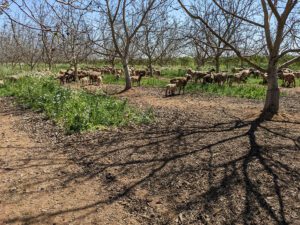
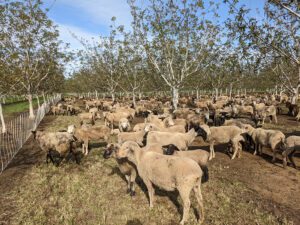
Q. How have farming practices evolved since you were a child, especially regarding nuts?
Melissa: When I was a child, we mainly grew row crops until we put in our first orchard, actually right where our house is now.
Drew: That was in 1981, when her father and grandfather decided to move away from row crops, which were becoming less financially viable. It’s a huge amount of work to prepare the ground for row crops, maintain the cycle and manage the harvest, especially on a smaller farm.
Melissa: Exactly. My dad saw how demanding row crops were on our family’s time and finances. So, he started diversifying by gradually taking out tomatoes, beans and sugar beets and putting in orchards. My grandfather didn’t love the idea; he was very old-school and attached to row crops, but my dad could see permanent crops were the way to go.
By the time I graduated from college, we had transitioned almost completely to orchards, primarily walnuts. I think we had around 300 acres of walnuts then, with plans to process them ourselves to be more financially sustainable in the long run.
Drew: Her father had a small walnut huller and dryer, and that’s when the focus really shifted to producing walnuts efficiently. Instead of paying someone else for processing, they controlled it on-site, and it made a huge difference financially.
Melissa: The farm continued to evolve, and now, besides walnuts, we also have almonds, cherries, alfalfa and olives. Over the past few years, we’ve focused on diversifying our income and reducing our dependence on any one crop, especially with how walnut prices have been declining.
Q. What kind of focus do you put on sustainability?
Drew: We’ve had to get creative with our farming practices to ensure sustainability. Five years ago, we started cover cropping, and now we cover crop all 1,000 acres. We also began grazing sheep in our orchards. It has been a process of learning to find a balance, but we’re seeing results in soil health, water retention and even fewer pests. It’s a more holistic approach to farming.
Melissa: Yes, and we’re seeing healthier ecosystems in our orchards. We’re seeing more pollinators, beneficial insects and birds. It’s a return to the way my great-grandfather farmed, with a focus on working with nature rather than against it.
Drew: Exactly. So, it’s not just about maximizing yield but about creating a sustainable, healthy environment. One of the most significant changes has been a focus on soil health. Without good soil, it doesn’t matter if you’re organic or conventional; everything you do just becomes a cycle of trying to replace what you’re taking out. Cover cropping and sheep grazing have made a huge impact, enriching the soil naturally and reducing the need for synthetic inputs.
Can you talk about some new ways you’re working to make the family farm profitable?
Melissa: It’s also about finding ways to diversify revenue streams on the farm. We’re looking at each acre and asking how we can make it more profitable without solely relying on harvests. It’s not just about the crops anymore; we’re considering everything from farm tours to farm-to-table events as new ways to sustain the farm financially.
Drew: That’s something we’re both passionate about: Making the farm sustainable not only economically but also environmentally. It’s become a way of life, where we think about how every action on the farm impacts the land, our community and the people who work with us.
Melissa: And we’re always asking, “How can we take care of the farm so it’s there for the next generation?” It’s about more than just today’s harvest.
Q. How do you feel about the current state of the nut industry? What changes do you think are needed for growers?
Drew: I think there needs to be a consolidated effort from all growers and handlers to work together rather than as separate, competing entities. We need collaboration to market and innovate the walnut industry, similar to what we see in almonds. If handlers could come together, it would help create more stable pricing and open up more product possibilities for walnuts.
Melissa: Exactly. Look at almonds; you see almond-based products everywhere, in every store. Walnuts, on the other hand, are usually just found in the baking aisle. We need to create more demand by developing new walnut products and working together as an industry. It’s something that should benefit all of us, and the potential is there.
Drew: There’s a lot that can be done with walnuts, but the industry needs to take the initiative. Instead of just waiting for consumers to dictate the market, the industry should invest in R&D to create new uses and products for walnuts similar to what’s been done with other nut industries.
Melissa: Yes, and it’s about creating a market for these products and supporting the growers. As walnut growers, we’re paying into this system, and we want to see that investment coming back to benefit us with new products and a stronger market presence.
Drew: There’s been a lot of discussion about using those funds to support direct benefits for growers and ensuring the industry is evolving to meet modern demands. We’re hoping to see that continue because it’s essential for the long-term viability of family farms.
Q. How do you give back to your community and balance that with everything else?
Melissa: This year, we started doing farm and harvest tours. Next week, we’re hosting our first school tour, which will include a pre-harvest visit and a follow-up during the actual harvest so kids can experience agriculture firsthand and see where their food comes from. It’s a way to connect with our community and educate our youth.
We’re also very active in 4-H. I’m the 4-H sheep leader, and our kids are involved as officers. We sponsor events, host fundraisers and even make cherry pizzas at our town’s annual Linden Cherry Festival event using cherries from our farm to benefit the local 4-H club. This year, we also started a “U-pick” cherry experience on our farm, which was very well-received by the community.
Drew: It’s all about education. We want people to understand where their food comes from and appreciate the work that goes into it. We also partnered with a local organization called Harvester Farms that gleans fruit to donate to food banks. It’s our way of making sure no food goes to waste and helping those in need.
Melissa: Giving back has become part of our family’s values. It’s been very fulfilling to engage with the community and share what we do on the farm, whether it’s through our 4-H activities, farm tours or simply opening up our farm for people to experience the land and connect with agriculture.
Q. You’ve talked a lot about sustainability, education and community. What role does fitness play in your lives and on the farm?
Melissa: Fitness is a huge part of our lives and… our farm’s identity. When we moved back here, I was coaching CrossFit out of our single-car garage. When we built our house, we decided to build a gym on the property too called One Body Whole Health. Now we have a full-scale gym offering CrossFit, FIT, yoga, pilates, water fitness and tumbling classes. It’s a big part of our life and community, and it aligns with the farm’s mission of wellness and sustainability.
Drew: Our gym has become a gathering place, and it’s fulfilling to offer this resource to our employees and neighbors. Farming can be very physically demanding, and health is often neglected, especially during long workdays. So, I call it “CropFIT” instead of CrossFit, focusing on exercises that build strength and endurance specifically for farming life.
Melissa: We even offer free gym memberships to our employees to encourage them to stay fit and healthy. It’s all about balance and making sure they’re in good health, both physically and mentally, to manage the demands of farm life. And for us, it’s another way to give back and strengthen the bond within our farm family.
Drew: Yes, and it’s not just about lifting weights; it’s about building resilience. Farming takes a toll on you, physically and mentally, so having that fitness base helps us and our team get through those long, hard days. It’s become part of our farm culture, promoting health, balance and wellness in every aspect of our lives.
Melissa: That’s why we’re marrying the concepts of fitness and farming, and hosting wellness workshops and retreats. In 2025, we’re planning to host farm-to-table dinners, integrating the farm’s commodities into the meals and using the gym as a space to promote overall wellness. It’s all part of our vision to bring fitness, farming, and food together as a lifestyle.
Q. Do you have any other secrets or surprises about your operation?
Melissa: One thing that surprises people is how much we integrate fitness and farming. When we have pictures taken for interviews, people are often surprised to see me in workout clothes and boots! It’s just the reality of balancing the gym and the farm. And our gym is literally in the middle of the farm, so it’s all very interconnected.
Drew: People often assume that farming is all we do, but it’s much more. People have layers, they have interests and skills that may not be obvious. For example, I used to teach martial arts, and that experience plays a big role in the work I do now with fitness on the farm. Being able to help others get healthy and strong in a practical, sustainable way is really rewarding.
Melissa: Growing up, my parents instilled in me that if you see something that needs change, you have to be the one to initiate it. “Be the change.” That’s become our motto; we want to model a sustainable and healthy way of farming that benefits the environment, our community and future generations. Our goal is to inspire others to think about sustainability, not just as a trend but as a necessary shift in mindset.
Drew: It’s really about changing the perspective. Farming has historically been about competition, keeping secrets, guarding techniques, not wanting others to know what’s working. But our philosophy is a rising tide raises all ships. If we can work together and learn from each other, the whole community benefits.
Melissa: Exactly. We need to collaborate, not only within our family but with other farmers. If all handlers and growers worked together, we could stabilize pricing and create more innovative products, benefiting everyone. That’s why we’re open about our practices and what’s working for us. We hope that our approach can inspire others to embrace a more collaborative, sustainable future.







